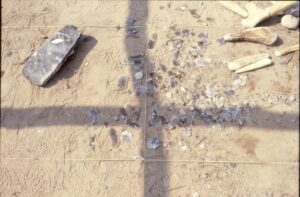
Humans, as I read recently, look for patterns, even meanings, in things. Archaeologists are used to dealing with things and we certainly like pattern. Half (a generalization) of our data is derived from material culture, the ‘things’ of the past; we deal with the everyday, and other, objects with which people were once familiar and which have survived to the present day. We construct our narratives about the past from the interpretation of these objects. In order to do that, we look for the patterns and we try to explain them. Some of the patterns are obvious: a row of round bottomed pots; a collection of leaf shaped arrowheads, we assume that groups of similar objects relate to a common template incorporating certain desires and functions. Other patterns can be more problematic: the different shapes of certain stone tools can, for example, seem to blend into one another; one shape of pot can, apparently, be replaced by another. All too often, we find ourselves requiring an explanation for the differences, rather than the similarities, in the material that we excavate.
Thus, we have long struggled to explain the meaning of the different types of material culture that we encounter and of the changes in material culture that we perceive. Essentially, much archaeology continues to use the foundations set by Gordon Childe in 1925 (drawing on the theories of, among others, a prominent German archaeologist, Gustav Kossinna), who considered that different suites of material culture could be used to identify different groups with different social commonalities. These groups were generally equated with human communities (known as ‘cultures’) – with the people of the past and the particular traits of behaviour and belief that identified them as separate from their neighbours. Thus, certain types of decorated pottery might define a particular ‘Culture’, let us call it the Round Bottomed Culture, which might, over time, evolve into another Culture with different pots, let us call this one the Square Bottomed Culture.
Childe was working without the benefit of radiocarbon analysis, and the rest of the suite of scientific techniques on which we rely today. He looked for patterns across the different types of archaeological evidence he had to hand, and the general assumption was made that as one element of material culture changed, so other elements would change too. This, it seemed, backed up the idea that social culture was reflected in material culture. Today, the system is cracking, and yet we still seem keen to fit the data into his paradigms.
It is not difficult to identify patterns of material culture, but we struggle with their explanation, and even more with the identification and explanation of the moments of change between them. It seems that it is hard to get away from the idea that when one element changes so should everything else. It is also hard to get away from the idea that material culture equals community. As we refine the evidence with which we work, so it becomes obvious that multiple elements of material culture rarely change together, yet few studies have tried to go back to basics and quantify the chronologies of change. It is, it seems, easier to live with the flawed but familiar understandings of the past. This has led to some big questions and discrepancies that we seem reluctant to challenge.
In the UK, our hunter-gatherer ancestors of the immediate post-glacial period, for example, used tiny stone tools that we call microliths. Microliths come in two basic ranges: Broad Blade Microliths and Narrow Blade Microliths. Many years ago, Roger Jacobi published a seminal work suggesting that the broad blade microliths were earlier and defined those communities able to maintain contact with Continental Europe while narrow blade microliths had developed later and were characteristic of subsequent communities developing within the more isolated environment of mainland Britain. Jacobi’s work has undoubtedly helped us to make sense of the Mesolithic communities of the British Isles but there are two problems with his explanation. Firstly, the assumption that a one-size-fits-all explanation will hold good for the whole of the UK: in actual fact, in the north of these islands the chronological precedence of broad blade microliths is still in question. Secondly, the assumption that microlith type equals community: it might, but then again it might not, and we have not really examined the alternatives.
Moving forward in time, the development of a highly decorated, flat bottomed, style of pottery in Neolithic Britain was at first considered to herald a new society: Piggott identified it as the ‘Rinyo-Clacton Culture’ in 1954. Today, we would be more circumspect in our interpretations: recent research has focussed on the possibilities of increasing complexity and sophistication developing within existing communities (Richards and Jones in their recent book); or the idea that it might form part of a package of goods associated with a complex belief system that spread across Britain to overlie existing society (as suggested in recent popular works). Or both!
We still find it hard to move away from the ingrained wisdom of archaeological greats such as Childe. But surely, the time is ripe to go back to basics and re consider some of those basic foundations on which our archaeological understanding rests. We have the tools to provide more sophisticated studies of material culture. We have the tools to examine whether apparently coincident change really occurs and, indeed, to look for other correlations for example between elements of material culture change and environmental dissonance.
Past archaeologists were seeking to explain the patterns, it seems to me that it is the explanation of change that forms the pressing question for our times.
You must be logged in to post a comment.